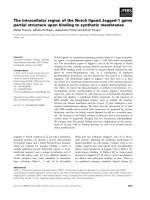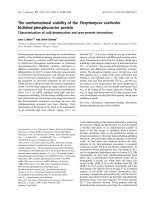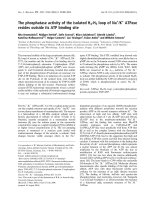báo cáo khoa học: "The geographical distribution of P-M hybrid dysgenesis in Drosophila melanogaster" ppt
Bạn đang xem bản rút gọn của tài liệu. Xem và tải ngay bản đầy đủ của tài liệu tại đây (437.1 KB, 11 trang )
The
geographical
distribution
of
P-M
hybrid
dysgenesis
in
Drosophila
melanogaster
D.
ANXOLABÉHÈRE,
HU
KAI
D. NOUAUD,
G.
PÉRIQUET
S.
RONSSERAY
Laboratoire
de
Génétique
des
Populations,
tour
42,
Université
Paris
VII
2,
place
Jussieu,
F
75005
Paris
*
Department
of
Biology,
Northwestern
University
Xian,
People’s
Republic
of
China
**
Institut
de
Biocénotique
expérimentale
des
Agrosystèmes,
Université
de
Tours
Parc
Grandmont, F
37200
Tours
Summary
In
Drosophila
melanogaster
the
syndrome
of
germline
abnormalities
generated
in
the
P-M
system
is
caused
by
transposable
elements
known
as
the
P
element
family.
The
fre-
quency
of
gonadal
dysgenesis,
GD
sterility
characteristic
of
the
P-M
system,
was
estimated
in
120
populations,
collected
in
1980-1983
from
arround
the
world,
in
order
to
determine
the
present
distribution
of
this
system
of
hybrid
dysgenesis.
Marked
geographical
differences
appear
between
these
populations.
In
North
America
most
of
them
possess
individuals
of
the
P
and
the
Q
type
whereas
the
M
type
is
absent
or
present
at
only
very
low
frequencies.
A
similar
pattern
has
been
found
in
central
Africa,
whereas
the
P
type
is
practically
absent
in
North
Africa,
Europe
and
Asia.
In
these
regions
another
pattern
exists.
In
France
the
Q
type
is
very
frequent
and
the
M
type
of
low
frequency,
whereas
M
becomes
very
common
going
to
the
east
of
Yugoslavia
and
Tunisia
towards
India,
China
and
Japan.
Hypotheses
on
the evolution
of
the
P-M
system
in
natural
populations
polymorphic
for
the
P
elements
will
be
discussed.
Key
words :
Transposable
elements,
populations,
polymorphism,
evolution.
Résumé
Répartition
géographique
du
système
P-M
de
dysgénésie
des
hybrides
chez
Drosophila
melanogaster
Chez
Drosophila
melanogaster
la
dysgénésie
des
hybrides
due
aux
éléments
transpo-
sables
de
la
famille
P
est
un
syndrome
d’anomalies
génétiques
incluant
une
stérilité
thermo-
dépendante
et
un
fort
taux
de
mutation.
Afin
de
déterminer
la
distribution
de
ce
système
parmi
les
populations
mondiales
de
drosophiles,
un
ensemble
de
120
souches
capturées
entre
1980
et
1983
a
été
étudié
pour
ses
potentialités
de
stérilité.
En
Amérique
du
Nord
la
plupart
des
populations
possède
des
individus
de
type
P
ou
Q
tandis
que
le
type
M
est
pratiquement
absent.
Une
répartition
similaire
a
été
observée
en
Afrique
centrale.
Dans
les
autres
régions
(Afrique
du
Nord,
Europe
et
Asie)
une
distribution
différente
est
observée,
dans
laquelle
le
type
P
est
pratiquement
absent.
Le
type
Q
très
fréquent
en
France
se
rencontre
moins
souvent
vers
l’est,
tandis
que
le
type
M
assez
rare
en
France
se
rencontre
très
fréquemment
de
la
Yougoslavie
au
Japon.
Les
hypothèses
de
l’évolution
du
système
P-M
dans
des
populations
naturelles
polymorphes
pour
les
éléments
P
sont
discutées.
Mots
clés :
Eléments
transposables,
populations,
polymorphisme,
évolution.
I.
Introduction
The
interactions
of
the
P-M
system
of
hybrid
dysgenesis,
which
are
manifested
in
certain
interstrain
hybrids,
result
in
a
number
of
correlated
aberrant
genetic
traits
such
as
high
frequencies
of
gonadal
sterility
(GD
sterility)
male
recombination
and
mutation
(K
IDWELL
et
al.,
1977).
In
the
P-M
system
three
types
of
individuals,
P,
Q
and
M,
have
been
described
on
the
basis
of
their
cross
effect
properties.
Hybrids
between
P
males
and
M
females
show
dysgenic
traits
that
are
reduced
or
absent
in
the
reciprocal
hybrids.
Q
individuals
do
not
exhibit
GD
sterility
in
any
cross
combinations
but
produce
mutation
and
male
recombination
in
crosses
with
M
females.
All
P
and
Q
strains
so
far
examined
carry
30-50
copies
of
the
P
family
of
elements
(Birrcantot
et
al.,
1982 ;
R
UBIN
et
al.,
1982).
Q
individuals
are
thought
to
be
a
subset
of
the
P
element
family
which
appear
to
lack
sterility
potentiality
while
retaining
mutator
activity
and
other
P
element
functions
(E
NGELS
,
1981 ;
P!RIQUET
et
al.,
1981 ;
R
UBIN
et
al.,
1982).
Conversely,
all-long-established
laboratory
M
strains
examined
(except
one),
comple-
tely
lacked
homology
with
the
P
element
family.
P
elements
are
subject
to
destabili-
sation
in
the
maternally
derived
celluLar
state
of
a
M
strain
(M
cytotype)
but
,are
quasi-stable
within
a
P
or
a
Q
cellular
state
(P
cytotype)
(E
NGELS
,
1979).
Although
much
previous
research
on
transposable
elements
has
been
on
their
molecular
properties,
little
is
known
about
the
population
genetics
of
such
sequences.
The
purpose
of
this
report
is
to
present
the
results
of
an
extensive
survey
of
actual
D.
melanogaster
populations
with
respect
to
their
dysgenic
potential
and
to
discuss
hypotheses
of
the
evolution
of
the
P-M
system.
11.
Materials
and
methods
120
strains
derived
from
diverse
localities
around
the
world
were
determined
with
respect
to
their
GD
sterility
potential.
Wherever
possible
each
strain
was
derived
from
a
large
number
(over
30)
of
recently
collected
(1980-1983)
individuals.
They
were
kept
in
standard
laboratory
conditions
by
mass
culture
of
about
500
individuals
and
normally
analysed
during
their
first
five
generations
following
capture.
For
each
strain
two
crosses
were
routinely
made
with
the
same
P
and
M
reference
lines.
Thirty
individuals
of
the
population
under
test
were mass
mated
as
follows :
Cross
A :
Canton-S
(M) ç
X a
under
test.
Cross
A *
: ç
under
test
X d
Harwich
(P).
Dissection
of
50
Fl
females
allowed
an
estimation
of
the
frequency
of
dysgenic
ovaries
(GD
sterility
criterion).
Cross
A
provided
a
measure
of
the
activity
of
P
factors
in
males,
and
P
strains
are
not
expected
to
produce
more
than
trivial
(5
p.
100)
levels
of
GD
sterility
in
cross
A*.
Cross
A*
distinguishes
between
M
cytotype
(>
5
p.
100
GD
sterility)
and
P
cytotype
(<
5
p.
100
GD
sterility).
Q
strains
are
defined
as
those
which
produce
less
than
5
p.
100
of
GD
sterility
both
in
crosses
A
and
A*.
Moreover,
potentiality
for
intrastrain
sterility
was
tested
in
each
M
strain
in
order
to
avoid
confusion
between
GD
sterility
and
maternally
inherited
sterility
of
character.
Such
as
grandchildless
(T
HIERRY
-M
EIG
,
1976)
or
atrophie
gonadique
(P
ERIQUET
,
1980).
The
frequencies
of
GD
sterility
were
estimated
using
the
method
of
K
IDWELL
et
al.
(1981).
The
data
(fig.
1 .and
tabl.
1)
show
marked
geographical
differences
in
the
present
distribution
of
the
P-M
system.
In
North
America
most
of
the
strains
show
P
activity
and
have
levels
of
induced
GD
sterility
which
fluctuate
around
an
average
value
of
15
p.
100.
According
to
the
technique
used
here
(mass
characterisation),
this
suggests
that
natural
populations
are
polymorphic
for
P
and
Q
types
as
has
been
previously
demonstrated
by
E
NGELS
&
P
RESTON
(1980)
in
a
natural
population
from
Madison
and
as
can
be
shown
here
in
the
Concord
iso-female
lines.
No
M
strains
have been
identifield
in
the
present
study
which
agrees
with
the
fact
that
M
strains
have been
found
very
rarely
in
modern
U.S.
populations
(K
IDWELL
,
1983).
In
our
study,
P
strains
have
also
been
found
in
South
America.
The
other
main
area
where
P
strains
has
been
found
is
Central
Africa
from
Senegal
to
Kenya.
In
these
regions
M
strains
also
appear
rare
and
the
observation
of
a
relatively
high
level
of
intra
sterility
in
one
Cotonou
strain
does
not
allow
its
classification
as
an
M
strain.
In
North
Africa,
Europe
and
Asia
the
distribution
patterns
change
dramatically,
P
strains
being
almost
absent
and
M
strains
very
common.
In
fact,
a
marked
diffe-
rence
has
been
found
between
north
western
Europe,
best
characterised
by
the
French
populations,
and
the
rest
of
Europe,
the
mediterranean
and
Asia.
In
France
most
current
strains
are
Q
ones
and
the
few
observed
M
strains
are
essentially
mediterranean.
Only
two
P
strains
have
been
found,
but
in
samples
collected
4
kms
apart,
and
thus
probably
representing
the
same
population.
In
all
other
regions
from
Yugoslavia
to
Japan,
a
majority
of
M
strains
has
been
characterised,
generally
with
a
high
level
of
GD
sterility.
However
some
Q
strains
have
also
been
found
and
this
observation
suggests
the
existence
of
cytotype
polymorphisms
in
these
areas,
as
has
been
demons-
trated
in
France,
Tunisia
and
Japan
(A
NXOLABEHERE
et
al.,
1982
a ;
Omsm
et
al.,
1982).
Nevertheless,
we
have
to
remember
that
if
the
patterns
of
all
these
regions
appear
devoid
of
P
strains,
this
situation
may
be
due
to
the
distribution
of
our
sampling
and
that
P
sporadic
types
might
exist
as
in
France.
Independently
of
the
modern
geographical
variation
K
IDWELL
(1983)
has
shown
temporal
trends
in
the
distribution
of
strains.
The
frequency
of
M
strains
is
positively
correlated
with
labo-
ratory
age
and
P
strains
do
not
appear
in
samples
taken
before
1950,
but
then
increase
rapidly
in
frequency.
To
explain
these
relationships
E
NGELS
(1981)
proposed
the
stochastic
loss
hypo-
thesis
in
which
the
temporal
trends
result
from
the
stochastic
loss
of
P
elements
when
flies
sampled
from
natural
populations
are
maintained
in
the
laboratory.
However
the
presence
of
numerous
M
strains in
the
wild
supports
the
idea
that
an
evolutionary
process
is
responsible
for
their
maintenance
in
natural
populations.
In
her
rapid
invasion
hypothesis,
K
IDWELL
(1983)
proposes
that
before
about
1950
almost
all
natural
populations
were
essentially
of
the
M
type,
the
P
element
family
being
absent
or
extremely
rare.
About
30
years
ago,
P
factors
rapidely
began
to
invade
natural
popu-
lations.
The
present
distribution
could
then
be
explained
by
the
complete
invasion
of
most
natural
populations
by
the
P
element
family,
but
the
structure
and
function
of
individual
elements
would
be
expected
to
vary
widely
due
to
internal
deletion
of
element
sequences
leading
to
Q
or
M
strains
in
different
areas.
However,
from
such
a
chiefly
random
process,
different
patches
of
homogeneity
can
be
generated
from
a
balance
between
migration
and
random
drift
(J
ONES
et
al.,
1981)
and
would
be
expected
to
lead
to
a
very
heterogeneous
geographical
distribution
rather
than
the
grouped
distribution
which
we
have
found.
Moreover,
naturally
occurring
polymor-
phisms
for
the
P
factors
(E
NGELS
&
P
RESTON
,
1980)
and
for
the
cytotype
(ANX
O
LA
-
B!HTRE
et
al.,
1’
982.a)
are
now
known.
To
include
these
data
A
NXOLAB
EHE
RE
&
P
ERIQUET
(1!983)
have
proposed
the
recurrent
phases
hypothesis
in
which
most
natural
populations
are
polymorphic
for
the
P
family
elements
both
in
number
and
structure.
P
elements
with
different
func-
tional
properties
are,
they
propose,
commonly
activated
or
inactivated
by,
for
example,
internal
recombination
between
elements.
The
process
of
dispersion
or
regression
of
such
elements
would
be
under
the
control
of
balancing
forces
such
as
the
rate
of
transposition,
the
occurrence
of
dysgenic
hybrids,
the
ratio
of
the
different
types
and
fluctuations
of
their
fitnesses
in
different
environments
(R
ONSSERAY
,
1984)
and
would
lead
to
successive
and
recurrent
periods
of
invasion,
stabilisation
and
regression,
not
necessarily
synchronous
over
the
whole
world.
During
those
periods,
P
elements
with
sterility
potentiality
can
be
«
inactivated
(e.g.
replaced
by
P
elements
devoid
of
the
sterility
potentiality
but
not
of
their
mutator
activity),
and
populations
poly-
morphic
for
the
cytotypes
(even
with
high
level
of
M
cytotype
as
in
Nasr’Allah)
can
exist.
In
such
populations
the
reappearence
of
potential
sterility
can
be
produced,
by
the
«
reactivation
or
the
reintroduction of
active
P
elements
and
a
new
invasion
phase
will
start
again.
This
evolutionary
hypothesis
is
supported
by
the
following
observations :
1)
some
strong
M
strains
from
North
Africa,
polymorphic
for
the
cytotypes,
have
also
revealed
some
structural
homology
with
a
cloned
P
element
(A
NXOLAB
EHE
RE
et
al.,
unpublished
data) ;
2)
in
the
U.S.A.
the
actual
P
factor
activity
of
strains
collected
before
1970
is,
average,
considerably
stronger
than
that
of
strains
collected
during
the
last
decade
(K
IDWELL
,
1983) ;
3)
a
similar
but
more
advanced
process
seems
to
have
occurred
in
France
(A
NXOLAB
ÉHÈ
RE
et
aL,
1982
b)
where
the
current
predominance
of
wild
Q
strains
follows
a
previous
period
(1963-1973)
in
which
P
and
M
strains
would
have
been
more
frequent;
4)
the
occurrence
of
periods
of
high
mutability
in
natural
populations
of
North
America,
Europe
and
Asia
(G
OLUBOVSKY
,
1980 ;
BERG,
1982) ;
and
5)
the
world-wide
distribution
patterns
described
here,
which
are
better
explained
by
deterministic
rather
than
only
stochastic
factors.
Received
July
4,
1983.
Accepted
August
30,
1983.
Acknowledgements
We
are
grateful
to
the
following
workers
who
sent
us
wild
caught
material :
F.J.
A
YALA
,
E.
B
AHN
,
Y.A.
Bouss
y,
J.
and
M.
B
OULETREAU
,
Y.
CARTON,
J.
DAVID,
R.
F
ALK
,
F
EI-J
ANN
L
IN
,
A.
F
LEURIE
T,
M.D.
GO
LUB
OVSKY,
H.N.
GOPALA
N,
J.M.
GOUX,
M.M.
GREEN,
W.E.
K
ALISCH
,
S.N.
KAR
ANJA
,
L.
KRIMB
A
S,
H.
KUROK
A
WA,
D.
LA
CHA
I
SE,
D.
M
ARIN
KOV
IC
,
M.
M
ATEC
H
CA
,
C.
MONCHAMP-MOREAU,
L.
PILARES
GUEVARA,
N.
PLUS,
G.
RI
BO
MO
N
CLUS,
J.
ROUA
U
LT
,
C.
T
ASTEMAIN
,
L.
T
SACAS
,
J.
VO
UIDIBI
O.
This
work
was
supported
by
grants
ERA
406,
LA
340
and
GRECO
44
from
the
C.N.R.S.
and
the
Mission
de
la
Recherche.
References
A
NXOLAB
ÉHÈ
RE
D.,
P
ERIQUET
G.,
1983.
Syst6me
P-M
de
dysgénésie
des
hybrides,
poly-
morphisme
génétique
et
evolution
des
populations
de
Drosophila
melanogaster.
Genet.
Sg
l.
Evol.,
15,
31-44.
A
NXOLAB
EHE
RE
D.,
N
OUAUD
D.,
P
ERIQUET
G.,
1982
a.
Cytotype
polymorphism
of
the
P-M
system
in
two
wild
populations
of
Drosophila
melanogaster.
Proc.
Natl.
Acad.
Sci.
USA,
79,
7801-7803.
ANXOLAB!H!RE
D.,
N
OUAUD
D.,
P
ERIQUET
G.,
1982
b.
Etude
de
la
variabilité
du
svstème
P-M
de
dysgénésie
des
hybrides
entre
populations
de
Drosophila
melanogaste
l.
C.R.
Acad.
Sci.
Paris,
294,
913-918.
BERG
R.L.,
1982.
Mutability
changes
in
Drosophila
melanogaster
populations
of
Europe,
Asia,
and
North
America
and
probable
mutability
changes
in
human
populations
of
the
U.S.S.R.
Jap.
J.
Genet.,
57,
171-183.
B
INGHAM
P.M.,
K
IDWELL
M.G.,
R
UBIN
G.M.,
1982.
The
molecular
basis
of
P-M
hybrid
dysgenesis :
the
role
of
the
P
element,
a
P-strainspecific
transposon
family.
Cell,
29,
995-1004.
E
NGELS
W.R.,
1979.
Hybrid
dysgenesis
in
Drosophila
melanogaster :
rules
of
inheritance
of
female
sterility.
Genet. Res.
Camb.,
33,
219-236.
E
NGELS
W.R.,
1981.
Hybrid
dysgenesis
and
the
stochastic
loss
hypothesis.
Cold
Spring
Harbor
Symp.
Quant.
Biol.,
45,
561-565.
E
NGELS
W.R.,
P
RESTON
C.R.,
1980.
Components
of
hybrid
dysgenesis
in
a
wild
population
of
Drosophila
melanogaster.
Genetics,
95,
111-128.
G
OLUBOVSKY
M.D.,
1980.
Mutational
process
and
microevolution.
Genetica,
52-53,
139-149.
JO
NES
J.S.,
B
RYANT
S.H.,
L
EWONTIN
R.C.,
M
OORE
J.A.,
P
ROUT
T.,
1981.
Gene
flow
and
the
geographical
distribution
of
a
molecular
polymorphism
in
Drosophila
pseudoobscura.
Genetics,
98,
157-170.
K
IDWELL
M.G.,
1983.
Evolution
of
hybrid
dysgenesis
determinants
in
Drosophila
melano-
gaster.
Proc.
Natl.
Acad.
Sci.
USA,
80,
1655-1659.
KID
WELL
M.G.,
K
IDWELL
J.F.,
S
VED
J.A.,
1977.
Hybrid
dysgenesis
in
Drosophila
melano-
gaster :
a
syndrome
of
aberrant
traits
including
mutation,
sterility
and
male
recombi-
nation.
Genetics,
86,
813-833.
K
IDWELL
M.G.,
NovY
J.B.,
F
EELEY
S.M.,
1981.
Rapid
unidirectional
change
of
hybrid
dysgenesis
potential
in
Drosophila.
J.
Hered.,
72,
32-38.
O
HISHI
K.,
T
AKANASHI
E.,
I
SHIWA
C
HIGUSA
S.,
1982.
Hybrid
dysgenesis
in
natural
popu-
lations
of
Drosophila
melanogaster
in
Japan.
I. -
Complete
absence
of
the
P
factor
in
an
island
population.
Jap.
J.
Genet.,
57,
423-428.
P
ERIQUET
G.,
1980.
« Atrophie
gonadique
»
character
and
hybrid
dysgenesis
in
Drosophila
melanogaster.
Biol.
Cell.,
39,
7-12.
P
ERIQUET
G.,
GREEN
M.,
A
NXOLAB
tHi
RE
D.,
1981.
Correlation
entre
activite
mutag6ne
et
dysgénésie
des
gonades
dans
une
souche
de
Drosophila
melanogaster.
Biol.
Cell.,
42,
181-184.
R
ONSERAY
S.,
1984.
Influence
de
la
temperature
sur
le
determinisme
cytotypique
et
sur
I’
g
volution
du
syst!me
P-M
chez
Drosophila
melanogaster.
These
(Doctorat
de
spécia-
lite),
Université
Paris
7.
R
UBIN
G.M.,
K
IDWELL
M.G.,
B
INGHAM
P.M.,
1982.
The
molecular
basis
of
P-M
hybrid
dysgenesis :
the
nature
of
induced
mutations.
Cell,
29,
987-994.
T
HIERRY
-M
IEG
D.,
1976.
Study
of
a
temperature-sensitive
mutant
Grandchildlesslike
in
Drosophila
melanogaster.
J.
Microsc.
Biol.
Cell.,
25,
1-6.









